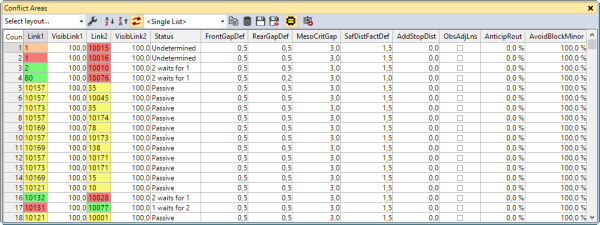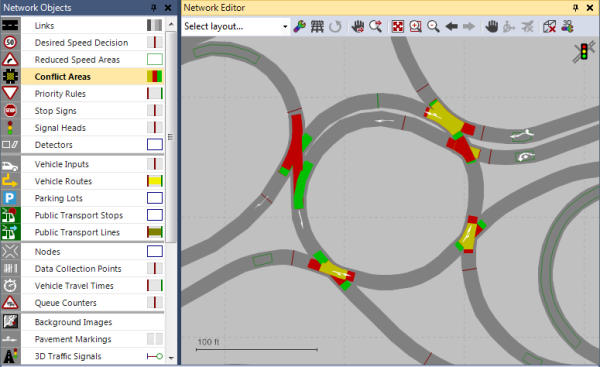Open topic with navigation
Using conflict areas
Using conflict areas that are automatically shown, you can model conflicts between vehicles on two links or connectors (Defining the right of way at conflict areas).
Use conflict areas instead of priority rules to model the right of way at intersections. Conflict areas are automatically displayed, are easier to edit and reflect the driving behavior better than priority rules (It is better to use conflict areas than priority rules to model driving behavior.).
Using conflict areas to model conflict types
The following conflict types may occur on a conflict area:
- Crossing: Two crossing links
- Merging: Two connectors lead to the same link or a connector leads to a link with other upstream traffic.
- Branching: Two connectors come off the same link or one connector comes off a link that continues further downstream for more than 0.5 m.
By default, the attribute Conflict type determined automatically is selected for the conflict area. This allows Vissim to determine the conflict area for the conflict type (Attributes of conflict areas).
Displaying conflict areas
On the network objects toolbar, click Conflict areas to automatically show conflict areas in the network, where two links or two connectors overlap. For each conflict area, you can select the link that has the right of way. The conflict area may also remain passive and thus without any impact on the vehicles.
Conflict areas are not inserted in the following cases:
- If the height (z coordinate) of both links or both links and the connector differs more than 1.0 m in their overlapping area.
- If the overlapping is less than or equal to 0.5 m
- If at least one of the links ends less than 5 m after the start of the conflict area and no connector begins in it. This does not apply for the following links:
- Connectors
- Links which are defined as pedestrian areas (Modeling links as pedestrian areas).
- Links with input flows with vehicle compositions which contain vehicle types with the category Pedestrians (Modeling vehicle compositions)
It is better to use conflict areas than priority rules to model driving behavior.
Conflict areas allow you to model driving behavior better than with priority rules, as in conflict areas, drivers plan how to traverse the conflict area:
A yielding driver watches the vehicles in the main traffic stream and then decides when to filter in. He then plans to accelerate for the next few seconds. Acceleration allows him to pass the conflict area. He thereby accounts for the traffic downstream from the conflict area. If he knows that he will have to stop or drive slowly because of other vehicles, he will account for more time to cross the conflict area or he will decide to wait for longer.
Vehicles in the main traffic stream also react to conflict areas: If a vehicle does not manage to cross the entire conflict area because the driver has misjudged the situation, the vehicle in the main traffic stream will brake or even stop. If a queue is forming at a signal control downstream of the conflict area, the drivers of the vehicles in the main traffic stream try not to stop within the conflict area in order not to block any crossing traffic. The drivers that have the right of way carry out a comparable decision-making process for crossing the conflict area as the drivers whose vehicles are yielding.
Colors indicate the status of conflict areas
The status of conflict areas is displayed in the Conflict Areas list and in the Network editor.
- Green: main flow (right of way)
- Red: minor flow (yield)
- Both red: for branching conflicts, so that vehicles can "see" each other. There is no right of way, as vehicles simply remain in their original sequence.
- Both yellow: passive conflict area without right of way

In the Network editor:

Display of different statuses:



Driving behavior at conflict areas
The driving behavior of vehicles approaching a conflict area shall produce the maximum capacity for a minor traffic stream, without affecting vehicles of the main traffic stream. Vehicles in the main traffic stream might be hindered by vehicles on the merge lane, the smaller the user-defined safety distance factor is.
- A vehicle in a minor traffic stream will calculate whether it will be able to filter into the main stream with every time step while approaching the conflict area. Thereby safety distances are taken into account (Defining the Wiedemann 74 model parameters), (Defining the Wiedemann 99 model parameters). If the driver feels there is a large enough gap in the main traffic stream, he will simply continue to drive. If the gap is too small, the vehicle will decelerate as if it had to stop in front of the conflict area. This calculation is repeated with the next time step. So braking is either cancelled or the driver continues driving and might even accelerate, e.g. when finding a gap in the traffic stream to enter.
- A vehicle on the main road is careful not to collide with any vehicles on the minor road. If it realizes that a vehicle on the minor road will still be within the conflict area when it arrives there, it will brake in order to reach the conflict area just after the other vehicle has left it. As decelerating causes it to arrive later, it might continue its journey without any further braking in a later time step and pass right after the vehicle on the minor road.
- A vehicle on a minor road will brake before reaching a conflict area, if there is not enough space downstream of the conflict area to leave it. This means that particularly when there are several adjacent conflict areas, drivers have to either pass all of them or none, if there is not enough space for a full vehicle length.
- With a conflict area of the conflict type crossing, a vehicle in the main stream will try to keep the conflict area clear, if this vehicle belongs the percentage specified in the Avoid blocking attribute (Attributes of conflict areas).
- A vehicle in the minor stream will not enter a conflict area if it has to assume that it will not be able to leave it before the next vehicle of the main stream arrives. It thereby takes the safety distance into account (Attributes of conflict areas)
- A vehicle of a minor stream that has already entered a conflict area will always try to leave it, even if this means that it has to enter another conflict area for which the Gap condition is not or no longer met.
- To avoid a collision, a vehicle may temporarily stop at an intersection within a red conflict area. If vehicle A recognizes that vehicle B is about to leave a conflict area, vehicle A can wait within another conflict area, for which it does not have the right of way, until B leaves.
- A vehicle waiting in a conflict area uses the next sufficiently large time gap to exit it. This behavior can also occur in a yielding vehicle, when it has to yield to the vehicle with the right of way. Example: A vehicle in a minor stream wants to turn into the major stream. It is waiting at an intersection in a conflict area because the vehicle in the major stream has the right of way. The vehicle in the major stream wants to turn left into the minor stream and is yielding because of oncoming traffic in the conflict area. However, if the time gap for the vehicle in the minor stream is sufficiently large, allowing it turn into the major stream in spite of the two vehicles, it leaves the conflict area and turns into the major stream. If you want a vehicle to take a clearance into account, define a priority rule (Modeling priority rules).






